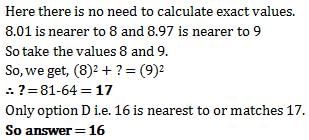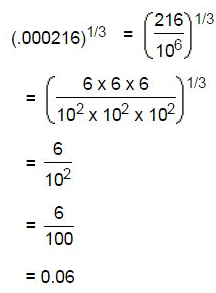All Exams >
DSSSB TGT/PGT/PRT >
General Intelligence & Reasoning Ability for DSSSB Exams >
All Questions
All questions of Space visualization for DSSSB TGT/PGT/PRT Exam
The cube of any multiple of 2 is always divisible by- a)16
- b)12
- c)8
- d)14
Correct answer is option 'C'. Can you explain this answer?
The cube of any multiple of 2 is always divisible by
a)
16
b)
12
c)
8
d)
14

|
EduRev CAT answered |
Cube of multiple of 2 is divisible by 8
eg:

eg:

Practice Quiz or MCQ (Multiple Choice Questions) with solution are available for Practice, which would help you prepare for "Cubes" under Logical Reasoning and Data Interpretative. You can practice these practice quizzes as per your speed and improvise the topic. The same topic is covered under various competitive examinations like - CAT, GMAT, Bank PO, SSC and other competitive examinations. Q. If volume of cube is 4913cm3 then length of side of cube is- a)16 cm
- b)17 cm
- c)18 cm
- d)19 cm
Correct answer is option 'B'. Can you explain this answer?
Practice Quiz or MCQ (Multiple Choice Questions) with solution are available for Practice, which would help you prepare for "Cubes" under Logical Reasoning and Data Interpretative. You can practice these practice quizzes as per your speed and improvise the topic. The same topic is covered under various competitive examinations like - CAT, GMAT, Bank PO, SSC and other competitive examinations.
Q. If volume of cube is 4913cm3 then length of side of cube is
a)
16 cm
b)
17 cm
c)
18 cm
d)
19 cm
|
|
Arun Sharma answered |
Let side be 'a'
volume of a cube=a3
a3 = 4913
a= ∛4913
a = 17cm
volume of a cube=a3
a3 = 4913
a= ∛4913
a = 17cm
Cube of a natural number will never end with the digit- a)0
- b)1
- c)3
- d)none of these
Correct answer is option 'D'. Can you explain this answer?
Cube of a natural number will never end with the digit
a)
0
b)
1
c)
3
d)
none of these
|
|
Arun Sharma answered |
There'd no such digit which can't end in a cube of a natural number. Hence a cube of a natural number can end with any digit.
1³= 1 (ends with 1)
2³= 8 (ends with 8)
3³= 27 (ends with 7)
4³= 64 (ends with 4)
5³= 125 (ends with 5)
6³= 216 (ends with 6)
7³= 343 (ends with 3)
8³= 512 (ends with 2)
9³= 729 (ends with 9)
0³= 0 (ends with 0)
Hence the last digits are 0,1,8,7,4,5,6,3,2,9
Therefore we see every digits are last digits of these cubes. Hence a cube of a natural number can end with any digit.
1³= 1 (ends with 1)
2³= 8 (ends with 8)
3³= 27 (ends with 7)
4³= 64 (ends with 4)
5³= 125 (ends with 5)
6³= 216 (ends with 6)
7³= 343 (ends with 3)
8³= 512 (ends with 2)
9³= 729 (ends with 9)
0³= 0 (ends with 0)
Hence the last digits are 0,1,8,7,4,5,6,3,2,9
Therefore we see every digits are last digits of these cubes. Hence a cube of a natural number can end with any digit.
Cubic root of 729 is- a)5
- b)6
- c)11
- d)9
Correct answer is option 'D'. Can you explain this answer?
Cubic root of 729 is
a)
5
b)
6
c)
11
d)
9
|
|
Kiran Reddy answered |
An integer is divisible by 9 if and only if the sum of its digits is divisible by 9.
The sum of the digits of 729 is 7 + 2 + 9 = 18 and 18 is divisible by 9 so 729 is divisible by 9.
Hence, the correct answer is Option D
If length of one side of cube is 20cm then volume of cube must be- a)8000cm3
- b)800cm3
- c)4000cm3
- d)6000cm3
Correct answer is option 'A'. Can you explain this answer?
If length of one side of cube is 20cm then volume of cube must be
a)
8000cm3
b)
800cm3
c)
4000cm3
d)
6000cm3
|
|
Aditya Kumar answered |
Volume of cube = a3
Given that side of a cube is 20cm
Then volume will be (20cm)3
Volume = 8000 cm3
What is the smallest number by which 3600 be divided to make it a perfect cube?- a)9
- b)50
- c)300
- d)450
Correct answer is option 'D'. Can you explain this answer?
What is the smallest number by which 3600 be divided to make it a perfect cube?
a)
9
b)
50
c)
300
d)
450

|
Raghavendra Sharma answered |
3600=23 X 52 X 32 X 2
To make it a perfect cube it must be divided by
52 X 32 X 2=450
Cube of 0.2 is- a)0.8
- b)0.08
- c)0.008
- d)none of these
Correct answer is option 'C'. Can you explain this answer?
Cube of 0.2 is
a)
0.8
b)
0.08
c)
0.008
d)
none of these

|
Ishani Rane answered |
(0.2)3 = 0.2 x 0.2 x 0.2 = 0.008
Therefore, cube of 0.2 is 0.008
Directions to Solve The figure given on the left hand side in each of the following questions is folded to form a box. Choose from the alternatives (1), (2), (3) and (4) the boxes that is similar to the box formed. Question - 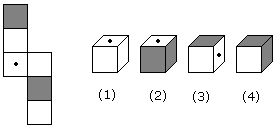
- a)2 and 3 only
- b)1, 3 and 4 only
- c)2 and 4 only
- d)1 and 4 only
Correct answer is option 'B'. Can you explain this answer?
Directions to Solve
The figure given on the left hand side in each of the following questions is folded to form a box. Choose from the alternatives (1), (2), (3) and (4) the boxes that is similar to the box formed.
Question - 
a)
2 and 3 only
b)
1, 3 and 4 only
c)
2 and 4 only
d)
1 and 4 only
|
|
Kiran Reddy answered |
As, shown in figure, these are opposite of each other. Thus, option (2) is correct.
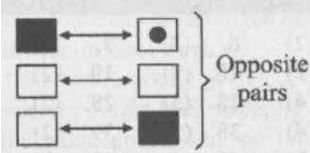

Two positions of dice are shown below. How many points will be on the top when 2 points are at the bottom?
- a)6
- b)5
- c)4
- d)1
Correct answer is option 'D'. Can you explain this answer?
Two positions of dice are shown below. How many points will be on the top when 2 points are at the bottom?

a)
6
b)
5
c)
4
d)
1

|
Janhavi Mishra answered |
In these 2 positions of a dice, one common face having points 3 is in the same position. Hence according to rule (3), there will be 4 points on the required face.
Six dice with upper faces erased are as shows. The sum of the numbers of dots on the opposite face is 7. Question - If the dice (I), (II) and (III) have even number of dots on their bottom faces, then what would be the total number of dots on their top faces?
The sum of the numbers of dots on the opposite face is 7. Question - If the dice (I), (II) and (III) have even number of dots on their bottom faces, then what would be the total number of dots on their top faces?- a)7
- b)11
- c)12
- d)14
Correct answer is option 'B'. Can you explain this answer?
Six dice with upper faces erased are as shows.

The sum of the numbers of dots on the opposite face is 7.
If the dice (I), (II) and (III) have even number of dots on their bottom faces, then what would be the total number of dots on their top faces?
a)
7
b)
11
c)
12
d)
14

|
Anjali Nair answered |
No. of dots on the top faces of dice (I), (II) and (III) are 5, 1 and 5 respectively.
Required total = 5 + 1 + 5 = 11
Which symbol will be on the face opposite to the face with symbol * ?

- a)@
- b)$
- c)8
- d)+
Correct answer is option 'C'. Can you explain this answer?
Which symbol will be on the face opposite to the face with symbol * ?

a)
@
b)
$
c)
8
d)
+

|
Alok Sen answered |
- The symbols of the adjacent faces to the face with symbol * are @, -, + and $.
- Hence the required symbol is 8.
Two positions of a dice are shown below. Which number will appear on the face opposite to the face with the number 5?
- a)2/6
- b)2
- c)6
- d)4
Correct answer is option 'C'. Can you explain this answer?
Two positions of a dice are shown below. Which number will appear on the face opposite to the face with the number 5?

a)
2/6
b)
2
c)
6
d)
4

|
Rajveer Ghoshal answered |
According to the rule no. (3), common faces with number 3, are in same positions. Hence the number of the opposite face to face with number 5 will be 6.
Number 343 is cube of- a)9
- b)7
- c)8
- d)6
Correct answer is option 'B'. Can you explain this answer?
Number 343 is cube of
a)
9
b)
7
c)
8
d)
6
|
|
Tata answered |
Ya it's correct 7 ×7=49then 49×7=343 ..
Directions to SolveThe figure given on the left hand side in each of the following questions is folded to form a box. Choose from the alternatives (1), (2), (3) and (4) the boxes that is similar to the box formed.Question - 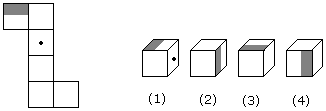
- a)1 and 2 only
- b)2 and 3 only
- c)1, 2, 3 and 4
- d)2 and 4 only
Correct answer is option 'C'. Can you explain this answer?
Directions to Solve
The figure given on the left hand side in each of the following questions is folded to form a box. Choose from the alternatives (1), (2), (3) and (4) the boxes that is similar to the box formed.
Question -

a)
1 and 2 only
b)
2 and 3 only
c)
1, 2, 3 and 4
d)
2 and 4 only

|
Nilanjan Biswas answered |
C
Cube of all even natural numbers is- a)even
- b)odd
- c)even or odd
- d)none of these
Correct answer is option 'A'. Can you explain this answer?
Cube of all even natural numbers is
a)
even
b)
odd
c)
even or odd
d)
none of these

|
S.v. Reddy answered |
Any even number to power 2 will have unit digit number
Example : 2^8=16÷8=2
16÷2=8
Example : 2^8=16÷8=2
16÷2=8
Two positions of dice are shown below. How many points will appear on the opposite to the face containing 5 points?
- a)3
- b)1
- c)2
- d)4
Correct answer is option 'D'. Can you explain this answer?
Two positions of dice are shown below. How many points will appear on the opposite to the face containing 5 points?

a)
3
b)
1
c)
2
d)
4

|
Amar Chavan answered |
In these two positions one of the common face having 1 point is in the same position. Therefore according to rule (2). There will be 4 points on the required face.
A cube of side n is painted green on all its sides. It is then cut into n3 identical cubes. How many of the smaller cubes will have three of its sides painted?- a)4
- b)6
- c)8
- d)Cannot be determined
Correct answer is option 'C'. Can you explain this answer?
A cube of side n is painted green on all its sides. It is then cut into n3 identical cubes. How many of the smaller cubes will have three of its sides painted?
a)
4
b)
6
c)
8
d)
Cannot be determined
|
|
Talent Triumphacademy answered |
Since, all the sides of the cube is painted, the cubes cut out from the corners will have three of its faces green. Since there are 8 corners for a cube, there will be 8 such cubes.
The smallest number by which 5400 must be multiplied so that it become a perfect cube, is- a)2
- b)10
- c)5
- d)3
Correct answer is option 'C'. Can you explain this answer?
The smallest number by which 5400 must be multiplied so that it become a perfect cube, is
a)
2
b)
10
c)
5
d)
3

|
Manoj Ghosh answered |
Find prime factors of 5400
5400=2x3x3x3x2x2x5x5
If we group them in the group of 3
5400=(2x2x2)x(3x3x3)x5x5
Here to make group of 3 for 5
We have to multiply 5400 by 5.
Answer is 5
Two positions of a cube with its surfaces numbered are shown below. When the surface 4 touch the bottom, what surface will be on the top?
- a)1
- b)2
- c)5
- d)6
Correct answer is option 'A'. Can you explain this answer?
Two positions of a cube with its surfaces numbered are shown below. When the surface 4 touch the bottom, what surface will be on the top?

a)
1
b)
2
c)
5
d)
6

|
Rajveer Ghoshal answered |
In these 2 positions one common face with number 1 is in the same position. Hence according to the rule number (3), 2 is opposite 6 and 3 is opposite to 5. Therefore opposite to 4 is 1.
From the four positions of a dice given below, find the color which is opposite to yellow ?
- a)Violet
- b)Red
- c)Rose
- d)Blue
Correct answer is option 'A'. Can you explain this answer?
From the four positions of a dice given below, find the color which is opposite to yellow ?

a)
Violet
b)
Red
c)
Rose
d)
Blue

|
Amar Chavan answered |
The colours adjacent to yellow are orange, blue, red and rose. Hence violet will be opposite to yellow.
Which digit will appear on the face opposite to the face with number 4?
- a)3
- b)5
- c)6
- d)2/3
Correct answer is option 'A'. Can you explain this answer?
Which digit will appear on the face opposite to the face with number 4?

a)
3
b)
5
c)
6
d)
2/3

|
Shivam Malik answered |
Here the common faces with number 3, are in same positions. Hence 6 is opposite to 2 and 5 is opposite to 1. Therefore 4 is opposite to 3.
Choose a box that is similar to the box formed from the given sheet of paper (X).
- a)3 only
- b)2 only
- c)1 only
- d)4 only
Correct answer is option 'C'. Can you explain this answer?
Choose a box that is similar to the box formed from the given sheet of paper (X).

a)
3 only
b)
2 only
c)
1 only
d)
4 only

|
EduRev CAT answered |
- When the given sheet depicted in the figure (X) is folded to form a hollow cube, the two half-shaded faces will lie opposite to each other, the face that features a square will lie opposite to one of the two blank faces in the sheet given, and the face with a circle will lie opposite to the other blank face in the sheet.
- So, the hollow cubes shown in the figure (2) and figure (3) that have two half-shaded faces that are adjacent to each other, is not possible to be made by folding the sheet depicted in the figure (X).
- Although the hollow cube depicted in the figure (4) has faces that may appear to be adjacent to each other but the hollow cube formed by folding the given sheet in the figure (X) cannot be rotated to form the hollow cube in the figure(4).
- Therefore, only the hollow cube in figure(1) is possible.
Here 4 positions of a cube are shown. Which sign will be opposite to '+' ?
- a)%
- b)-
- c)x
- d)$
Correct answer is option 'C'. Can you explain this answer?
Here 4 positions of a cube are shown. Which sign will be opposite to '+' ?

a)
%
b)
-
c)
x
d)
$

|
Anjali Nair answered |
From position I and III common face with % is in the same position. Hence according to rule (3) opposite is X.
How many points will be on the face opposite to in face which contains 2 points?
- a)1
- b)5
- c)4
- d)6
Correct answer is option 'D'. Can you explain this answer?
How many points will be on the face opposite to in face which contains 2 points?

a)
1
b)
5
c)
4
d)
6

|
Sravya Deshpande answered |
In first two positions of dice one common face containing 5 is same. Therefore according to rule no. (3) the face opposite to the face which contains 2 point, will contains 6 points.
Directions to Solve Six dice with upper faces erased are as shows. The sum of the numbers of dots on the opposite face is 7. Question - If the odd numbered dice have even number of dots on their top faces, then what would be the total number of dots on the top faces of their dice?
The sum of the numbers of dots on the opposite face is 7. Question - If the odd numbered dice have even number of dots on their top faces, then what would be the total number of dots on the top faces of their dice?- a)8
- b)10
- c)12
- d)14
Correct answer is option 'A'. Can you explain this answer?
Directions to Solve
Six dice with upper faces erased are as shows.

The sum of the numbers of dots on the opposite face is 7.
If the odd numbered dice have even number of dots on their top faces, then what would be the total number of dots on the top faces of their dice?
a)
8
b)
10
c)
12
d)
14

|
Rajveer Ghoshal answered |
Odd numbered dice are : (II), (III) and (V)
No. of dots on the top faces of these dice are 2, 2 and 4 respectively.
Required total = 2 + 2 + 4 = 8
Two positions of a cubical block are shown. When 5 is at the top which number will be at bottom?
- a)1
- b)2
- c)3
- d)4
Correct answer is option 'C'. Can you explain this answer?
Two positions of a cubical block are shown. When 5 is at the top which number will be at bottom?

a)
1
b)
2
c)
3
d)
4

|
Amar Chavan answered |
In these 2 positions one common face with number 3, is in same position. Hence according to rule (3), 1 is opposite to 6 and 4 is opposite to 2. Therefore 5 is opposite to 3.
Two positions of a dice are shown below. When number '1' is on the top. What number will be at the bottom?
- a)3
- b)5
- c)2
- d)6
Correct answer is option 'B'. Can you explain this answer?
Two positions of a dice are shown below. When number '1' is on the top. What number will be at the bottom?

a)
3
b)
5
c)
2
d)
6

|
Amar Chavan answered |
According to the rule (2) when 'one' is at the top, then 5 will be at the bottom.
Directions to Solve Six dice with upper faces erased are as shows. The sum of the numbers of dots on the opposite face is 7. Question - If even numbered dice have even number of dots on their top faces, then what would be the total number of dots on the top faces of their dice?
The sum of the numbers of dots on the opposite face is 7. Question - If even numbered dice have even number of dots on their top faces, then what would be the total number of dots on the top faces of their dice?- a)12
- b)14
- c)18
- d)24
Correct answer is option 'C'. Can you explain this answer?
Directions to Solve
Six dice with upper faces erased are as shows.

The sum of the numbers of dots on the opposite face is 7.
If even numbered dice have even number of dots on their top faces, then what would be the total number of dots on the top faces of their dice?
a)
12
b)
14
c)
18
d)
24

|
Amar Chavan answered |
Even numbered dice are: (II), (IV) and (VI)
No. of dots on the top face of (II) dice = 6
No. of dots on the top face of (IV) dice = 6
and No. of dots on the top face of (VI) dice = 6
Therefore Required total = 6 + 6 + 6 = 18
Here two positions of dice are shown. If there are two dots in the bottom, then how many dots will be on the top?
- a)2
- b)3
- c)5
- d)6
Correct answer is option 'C'. Can you explain this answer?
Here two positions of dice are shown. If there are two dots in the bottom, then how many dots will be on the top?

a)
2
b)
3
c)
5
d)
6

|
Snehal Nambiar answered |
Here the common faces with 4 dots are in same positions.
Hence 2 will be opposite to 5.
How many points will be on the face opposite to the face which contains 3 points?
- a)2
- b)4
- c)5
- d)6
Correct answer is option 'C'. Can you explain this answer?
How many points will be on the face opposite to the face which contains 3 points?

a)
2
b)
4
c)
5
d)
6

|
Dipika Dasgupta answered |
The adjacent faces to the face which 3 points have 2, 1, 4 and 6 points. Hence on the face which is opposite to the face which contains 3 points, there will be 5 points.
Directions to Solve
Six dice with upper faces erased are as shows.
 The sum of the numbers of dots on the opposite face is 7.
Question -
If the even numbers of dice have odd number of dots on their top faces and odd numbered dice have even of dots on their bottom faces, then what would be the total number of dots on their top faces?
The sum of the numbers of dots on the opposite face is 7.
Question -
If the even numbers of dice have odd number of dots on their top faces and odd numbered dice have even of dots on their bottom faces, then what would be the total number of dots on their top faces?
- a)12
- b)14
- c)16
- d)18
Correct answer is option 'C'. Can you explain this answer?
Directions to Solve
Six dice with upper faces erased are as shows.

The sum of the numbers of dots on the opposite face is 7.
Question -
If the even numbers of dice have odd number of dots on their top faces and odd numbered dice have even of dots on their bottom faces, then what would be the total number of dots on their top faces?
a)
12
b)
14
c)
16
d)
18

|
Lakshmi Nair answered |
No. of dots on the top faces of the dice (II), (IV) and (VI) are 1, 1 and 1 respectively.
No. of dots on the top faces of the dice (I), (III) and (V) are 5, 5 and 3 respectively.
Required total = 5 + 5 + 3 + 1 + 1 + 1 = 16
Which number is on the face opposite to 6?
- a)4
- b)1
- c)2
- d)3
Correct answer is option 'B'. Can you explain this answer?
Which number is on the face opposite to 6?

a)
4
b)
1
c)
2
d)
3

|
Mansi Kumar answered |
As the numbers 2, 3, 4 and 5 are adjacent to 6. Hence the number on the face opposite to 6 is 1.
When the digit 5 is on the bottom then which number will be on its upper surface?
- a)1
- b)3
- c)4
- d)6
Correct answer is option 'A'. Can you explain this answer?
When the digit 5 is on the bottom then which number will be on its upper surface?

a)
1
b)
3
c)
4
d)
6

|
Rajveer Ghoshal answered |
According to the rule no. (3), common faces with number 2 are in same positions. Hence when the digit 5 is on the bottom then 1 will on the upper surface.
The figure given on the left hand side in each of the following questions is folded to form a box. Choose from the alternatives (1), (2), (3) and (4) the boxes that is similar to the box formed. Question - 
- a)1 only
- b)2 only
- c)3 only
- d)4 only
Correct answer is option 'A'. Can you explain this answer?
The figure given on the left hand side in each of the following questions is folded to form a box. Choose from the alternatives (1), (2), (3) and (4) the boxes that is similar to the box formed.
Question - 
a)
1 only
b)
2 only
c)
3 only
d)
4 only
|
|
Dishani Sengupta answered |
The pattern on fig. (X) and also the fact that the faces are rectangle, indicate that only fig. (1) can be obtained by folding fig. (X).
Cube root of 0.064 is- a)0.04
- b) 0.004
- c)0.4
- d)none of these
Correct answer is option 'C'. Can you explain this answer?
Cube root of 0.064 is
a)
0.04
b)
0.004
c)
0.4
d)
none of these

|
Sameer Rane answered |
0.064 = 64/1000= 4^3 / 10^3 =(4/10)^3= (2/5)^3
taking cube root of 0.064= 2/5=0.4
Directions to Solve Six dice with upper faces erased are as shows. The sum of the numbers of dots on the opposite face is 7. Question - If dice (I), (II) and (III) have even number of dots on their bottom faces and the dice (IV), (V) and (VI) have odd number of dots on their top faces, then what would be the difference in the total number of top faces between there two sets?
The sum of the numbers of dots on the opposite face is 7. Question - If dice (I), (II) and (III) have even number of dots on their bottom faces and the dice (IV), (V) and (VI) have odd number of dots on their top faces, then what would be the difference in the total number of top faces between there two sets?- a)0
- b)2
- c)4
- d)6
Correct answer is option 'D'. Can you explain this answer?
Directions to Solve
Six dice with upper faces erased are as shows.

The sum of the numbers of dots on the opposite face is 7.
If dice (I), (II) and (III) have even number of dots on their bottom faces and the dice (IV), (V) and (VI) have odd number of dots on their top faces, then what would be the difference in the total number of top faces between there two sets?
a)
0
b)
2
c)
4
d)
6

|
Lakshmi Nair answered |
No. of faces on the top faces of the dice (I), (II) and (III) are 5, 1 and 5 respectively.
Therefore, Total of these numbers = 5 + 1 + 5 = 11
No. of dots on the top faces of the dice (IV), (V) and (VI) are 1, 3 and 1 respectively.
Therefore, Total of these numbers = 1 + 3 + 1 = 5
Required difference = 11 - 5 = 6
Chapter doubts & questions for Space visualization - General Intelligence & Reasoning Ability for DSSSB Exams 2025 is part of DSSSB TGT/PGT/PRT exam preparation. The chapters have been prepared according to the DSSSB TGT/PGT/PRT exam syllabus. The Chapter doubts & questions, notes, tests & MCQs are made for DSSSB TGT/PGT/PRT 2025 Exam. Find important definitions, questions, notes, meanings, examples, exercises, MCQs and online tests here.
Chapter doubts & questions of Space visualization - General Intelligence & Reasoning Ability for DSSSB Exams in English & Hindi are available as part of DSSSB TGT/PGT/PRT exam.
Download more important topics, notes, lectures and mock test series for DSSSB TGT/PGT/PRT Exam by signing up for free.
General Intelligence & Reasoning Ability for DSSSB Exams
83 videos|39 docs|89 tests
|

Contact Support
Our team is online on weekdays between 10 AM - 7 PM
Typical reply within 3 hours
|
Free Exam Preparation
at your Fingertips!
Access Free Study Material - Test Series, Structured Courses, Free Videos & Study Notes and Prepare for Your Exam With Ease

 Join the 10M+ students on EduRev
Join the 10M+ students on EduRev
|

|
Create your account for free
OR
Forgot Password
OR
Signup to see your scores
go up
within 7 days!
within 7 days!
Takes less than 10 seconds to signup

